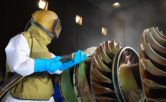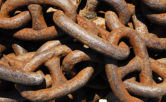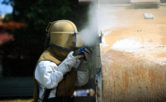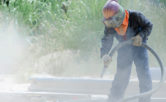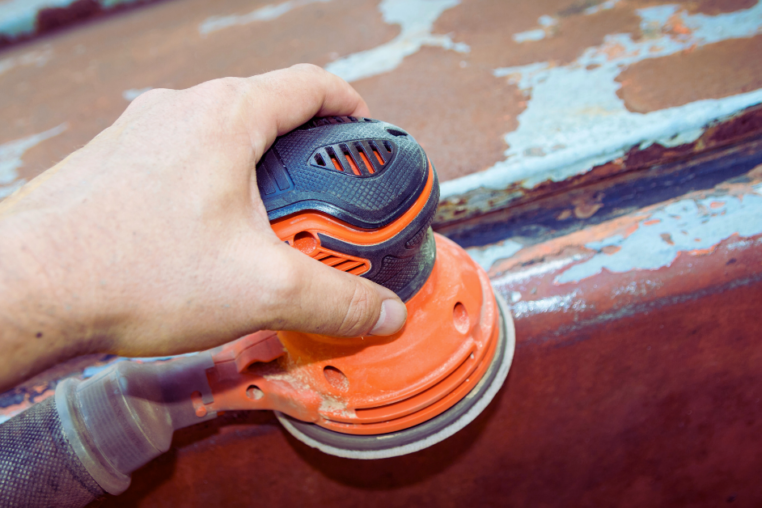
How to Remove Rust in an Environmentally Friendly Way
Got rusty tools, furniture, or outdoor equipment? You don’t need harsh chemicals to bring them back to life. Your kitchen pantry probably has most of what you need to tackle rust the natural way. Plus, there are simple, earth-friendly solutions for keeping rust from coming back.
In this guide, you’ll learn what causes rust in the first place, discover easy DIY cleaning methods using common household items, and find out learn how to protect your metal stuff for years to come. We’ll show you everything from quick fixes to long-term solutions that work – and they’re all safe for you and the environment.
Why Does Metal Rust?
Rust is nature’s way of breaking down metal – specifically iron and steel – through a process that happens when metal meets water and air. That reddish-brown flaking isn’t just unsightly; it’s actually the metal actively breaking down, much like how copper turns green or silver tarnishes.
Here’s what drives the process:
- Water is the catalyst – whether from rain, humidity, or morning dew. When water sits on metal, it starts breaking down the surface.
- Air plays a crucial role too. The oxygen in the air combines with the wet metal to create rust.
- Several factors can speed up rust formation:
- Salt (explaining why coastal areas see more rust damage)
- High humidity and frequent rainfall
- Industrial pollutants
- Acidic substances like tree sap
Left unchecked, rust will continue to eat through metal, weakening it over time. But understanding how rust forms is the first step to preventing it, – and that’s where the natural solutions in this guide come in.
5 Easy Ways to Remove Rust Using Household Items
You don’t need to buy expensive chemical rust removers to get the job done. Your kitchen already has some of the most effective rust-fighting ingredients around. Here are several proven methods that work well for different situations:
1. Vinegar and Baking Soda
How It Works: Vinegar contains acetic acid, which reacts with rust (iron oxide) to dissolve it. Baking soda helps neutralize the acidity afterward and can scrub away any remaining rust particles.
Step-by-Step Process:
- Submerge the rusted object in white vinegar for 4–12 hours, depending on the level of rust. For larger items, apply vinegar with a cloth or spray bottle.
- Once the rust has softened, remove the item and use a baking soda paste (baking soda + water) to scrub away remaining rust.
- Rinse the object with water and dry it thoroughly to prevent further rusting.
Tip: Always dry the object completely after cleaning, as any leftover moisture can reactivate start the rusting process again.
2. Lemon Juice and Salt
How It Works: Lemon juice is rich in citric acid, which helps break down rust, while salt acts as an abrasive to remove it more effectively.
Step-by-Step Process:
- Sprinkle a generous amount of salt on the rusted area.
- Squeeze fresh lemon juice over the salt to create a slightly thick paste.
- Let the mixture sit for at least 2–3 hours to allow the acid to react with the rust.
- Use a scrubbing pad or an old toothbrush to scrub off the rust gently.
- Rinse with water and dry the surface completely.
Tip: For tougher rust, you can repeat the process or let the mixture sit overnight.
3. Potato and Dish Soap
How It Works: Potatoes contain oxalic acid, a natural rust remover that breaks down iron oxide. Dish soap helps lift grime and grease, making the process even more effective.
Step-by-Step Process:
- Cut a potato in half and coat the cut side with a small amount of dish soap.
- Sprinkle baking soda or salt onto the soapy potato for added abrasiveness.
- Rub the potato directly on the rusted area, applying slight pressure. For larger items, leave the potato pressed against the rust for 1–2 hours.
- Check the progress and scrub gently with the potato to remove remaining rust.
- Rinse the item with water and dry thoroughly.
Tip: If the rust persists, cut off the top layer of the potato and reapply the dish soap and salt for a fresh surface.
4. Aluminum Foil
How It Works: Aluminum foil is a gentle yet effective material for removing rust. When rubbed against a rusted metal surface, aluminum creates a reaction with the rust, breaking it down without scratching the surface.
Step-by-Step Process:
- Tear off a piece of aluminum foil and crumple it into a ball.
- Dip the foil into water (you can also use vinegar for added effectiveness).
- Gently scrub the rusted area with the foil, using circular or back-and-forth motions.
- Wipe the surface clean with a damp cloth to check the progress.
- Repeat as necessary until the rust is removed.
Why It Works: Aluminum is softer than iron or steel, which prevents it from scratching the surface. As the aluminum foil rubs against the rust, it also produces a light aluminum oxide layer that can help polish and protect the metal.
Tip: For chrome surfaces (e.g., car bumpers or tools), aluminum foil is particularly effective and leaves a shiny finish.
5. Wire Brushing
How It Works: Wire brushes are manual tools designed to scrape off rust by physically abrading the corroded surface. They are excellent for stubborn rust spots and hard-to-reach areas, but care must be taken to avoid damaging the metal underneath.
Step-by-Step Process:
- Choose the right wire brush for your surface. Use softer brushes (like brass) for delicate metals and tougher brushes (like steel) for heavily rusted items.
- Gently scrub the rusted surface in short, controlled motions. Avoid applying excessive pressure, as this can scratch or gouge the metal.
- For detailed work, consider using a wire brush attachment on a drill for precision and speed.
- After scrubbing, wipe away loose rust particles with a cloth and inspect the surface.
- If needed, follow up with an eco-friendly rust remover (like vinegar) to clean any remaining rust residue.
Tip: Always wear protective gloves and safety glasses when using wire brushes to avoid injury from loose bristles or rust particles.
How to Prevent Rust from Forming
Stop rust before it starts. Prevention takes just a few minutes and can save you hours of cleanup later. These proven rust prevention techniques will protect your metal items and keep them looking great for years. Here’s what to do:
1. Proper Storage
Moisture is rust’s worst enemy, so proper storage is essential:
- Keep metals dry: Store tools, equipment, and other metal items in a dry, well-ventilated area.
- Use moisture-absorbing materials: Place silica gel packs, dehumidifiers, or moisture-absorbing products in storage areas to minimize humidity.
- Avoid contact with water: Always wipe down metal surfaces after exposure to rain, spills, or humidity.
Tip: For outdoor metal objects, consider using waterproof covers when not in use.
2. Regular Maintenance
Routine upkeep prevents small issues from turning into large-scale rust problems:
- Inspect regularly: Check metal surfaces for early signs of rust or moisture buildup. Catching rust early makes it much easier to manage.
- Clean frequently: Use a damp cloth to remove dirt, dust, and grime that can trap moisture against the metal.
- Reapply protective layers: If you notice a coating starting to wear down (e.g., paint, oil, or wax), refresh it to ensure ongoing protection.
Tip: For tools and machinery, apply a light coat of machine oil or mineral oil to prevent oxidation.
3. Use Protective Coatings
Different metal items need different levels of protection. While some solutions work well for DIY applications, others benefit from professional expertise. Here’s a guide to help you choose:
For DIY Protection:
- Rust-resistant paint works well for outdoor furniture and gates. Look for labels marked “anti-rust” or “rust-inhibiting.”
- Regular coats of car wax, machine oil, or WD-40 help protect tools and machinery from moisture.
- Clear sealants can protect smaller items and are easy to apply at home.
For Long-Term Protection:
- Professional powder coating offers superior durability and comes in countless colors. While it costs more upfront than paint, it typically lasts 15-20 years.
- Industrial galvanization (zinc plating) provides excellent protection for outdoor items. This specialized process creates a nearly rust-proof surface. However, it can fall short when compared to powder coating when compared on factors such as customization, costs, and environmentally-friendliness
- Industrial-grade ceramic coatings also offer the ultimate protection for high-value items.
Need Professional Protection?
For items that deserve lasting protection, AR Powder Coating specializes in environmentally friendly powder coating services. Our advanced techniques provide a durable, attractive finish that protects your metal for decades while keeping harmful chemicals out of the environment.
4. Control Environmental Factors
Minimize the conditions that promote rust formation:
- Reduce humidity: In storage areas like garages, workshops, or basements, use a dehumidifier to maintain a dry environment.
Protect from salt exposure: If you live in coastal areas or use salt for snow removal, regularly rinse metal surfaces to remove salt residue.
Which Rust Removal Method Should You Use?
Item Type | Rust Level | Best Method | Why It Works | When to Consider Professional Help |
Small Tools & Hardware | Light to Medium | Vinegar Soak | Easy to submerge, acid penetrates rust effectively | When item is valuable or antique |
Kitchen Items & Utensils | Light | Lemon & Salt | Food-safe ingredients, gentle on surfaces | If rust persists after 2-3 treatments |
Outdoor Furniture | Medium to Heavy | Wire Brush + Vinegar | Covers large areas, removes deep rust | When rust is extensive or item is expensive |
Chrome Surfaces | Light to Medium | Aluminum Foil | Won't scratch, polishes while cleaning | If chrome is peeling or heavily pitted |
Delicate Items | Light | Potato Method | Very gentle, won't damage surface | When item has historical value |
Heavy Equipment | Heavy | Professional Powder Coating | Complete removal and protection | When rust keeps returning or item is critical |
Large Metal Pieces | Any | Professional Media Blasting + Powder Coating | Most thorough and longest-lasting solution | When appearance matters or item is exposed to elements |
Choose AR Powder Coating for Lasting Protection
Whether you choose DIY solutions or professional help, protecting your metal items from rust doesn’t have to harm the environment. Natural methods work well for many household items, while professional powder coating provides long-lasting protection for valuable pieces.
For industrial-grade protection, trust AR Powder Coating’s expertise. As a division of AR Iron, one of the few AAMA-certified companies in the Western US, we’ve been protecting metal surfaces since 1989. Our environmentally friendly process removes rust and provides decades of protection without harmful chemicals.
Ready to protect your metal items? Contact our Henderson-based team at AR Powder Coating to learn more.

